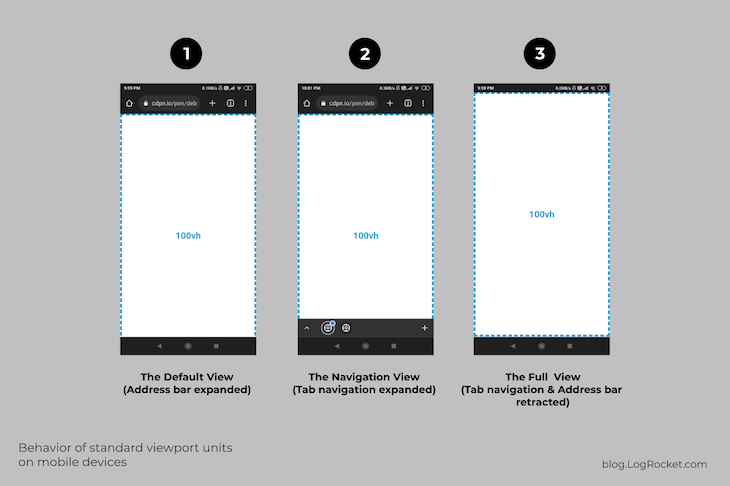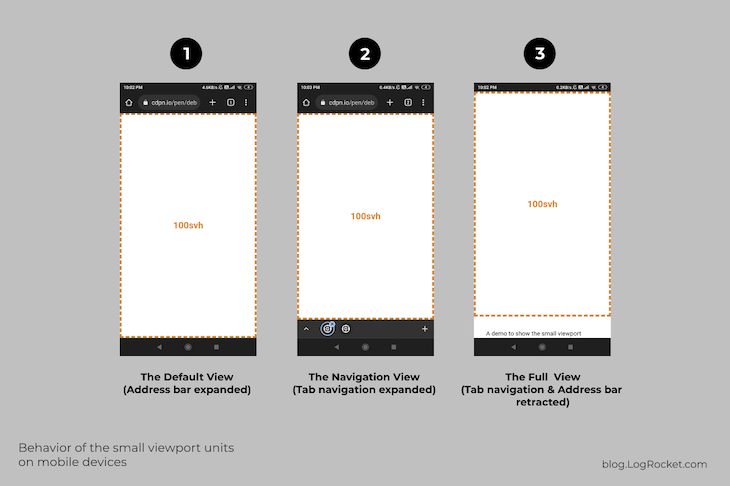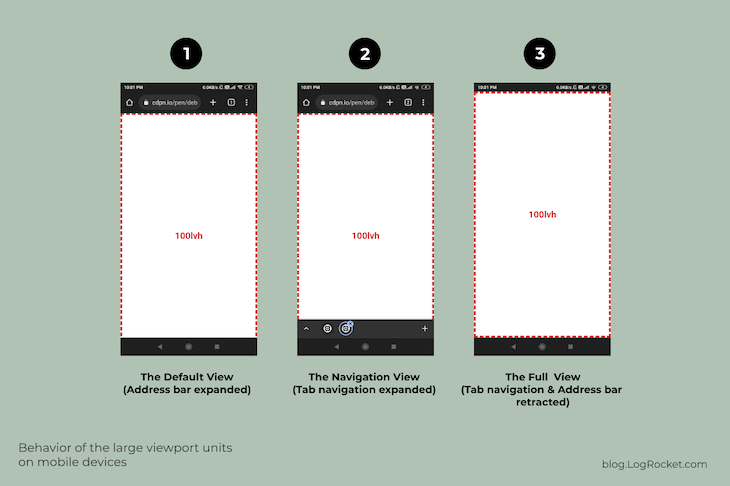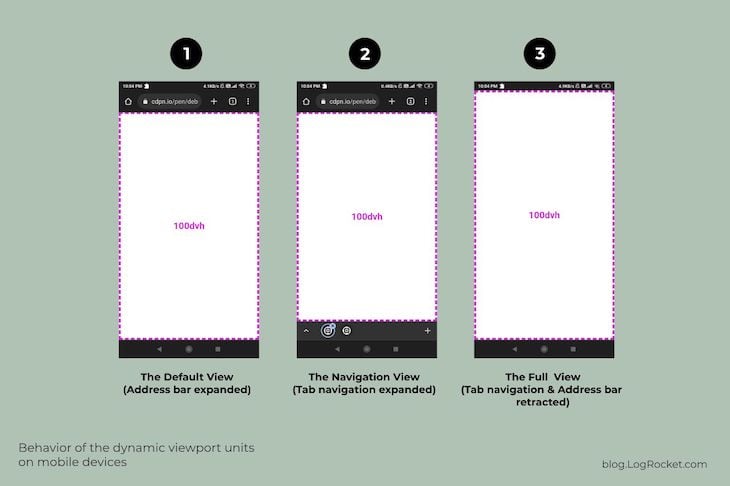
Despite being around for a while, CSS viewport-relative units are not as widely used as other CSS units due to their complexity, along with the potential for design inconsistencies if not implemented correctly.

The issues that the initial set of CSS viewport units cause are more apparent on mobile devices when the browser’s toolbars — such as the address bar, tab navigation, and others — expand or retract. To address these issues, the CSS Working Group has recently introduced global browser support for small, large, and dynamic viewport units.
This article examines the difficulties associated with utilizing CSS viewport-relative units and illustrates how recent advancements in these units have been crafted to overcome these challenges.
The Replay is a weekly newsletter for dev and engineering leaders.
Delivered once a week, it's your curated guide to the most important conversations around frontend dev, emerging AI tools, and the state of modern software.
Before delving into the topic of viewport units, it’s essential to have an understanding of the viewport. The viewport refers to the portion of the screen that is utilized to display the content of a web page.
In simpler terms, the viewport can be thought of as the “window” through which a user views and navigates a website. When working with mobile-responsive layouts, the same viewport area is sized using the viewport meta tag.
The following is the typical viewport meta tag template used to instruct the viewport to utilize the full width available in the device or browser:
<meta name="viewport" content="width=device-width, initial-scale=1">
The following example uses the viewport meta tag implementation and CSS to highlight the viewport area:
See the Pen CSS Viewport Meta Tag Implementation Demo by Rahul Chhodde (@_rahul)
on CodePen.
The viewport meta tag also includes a device-height setting for the height property, which is used to size the viewport vertically. However, since browsing websites typically involves scrolling vertically, the device-height setting is not commonly used.
The viewport is the area where all HTML elements are displayed. To size these elements in proportion to the viewport, we use viewport units, which will be discussed in greater detail in the next section.
There are various units — percentage, em andrem, px, viewport-relative units, and others — that can be used to size up HTML elements. To make the element size relative to the viewport, we use CSS viewport or viewport-relative units.
Unlike percentage units — which size based on the size of their parent — CSS viewport units size according to the viewport size. As they are entirely dependent on the viewport size to function, they are also known as viewport-relative units.
Let’s explore specific use cases for each of the most widely used CSS viewport units. This understanding will serve as a foundation for the new viewport units.
The viewport width unit, or 1vw, represents one percent of the viewport’s width. As discussed earlier, it is relative to the viewport width and not to the parent’s width.
For instance, if you want an image to extend beyond its parent container without using the CSS grid tweaks, adjusting the image’s width with percentage units can be inconvenient. In comparison, doing so with the viewport width unit is more straightforward:
.bleed-out {
width: 75vw;
position: relative;
left: 50%;
transform: translateX(-50%);
}
The code above assigns 75 percent of the available viewport width to the .bleed-out element. The remaining CSS adjustments are used to center the element horizontally. A working example of this is provided below:
See the Pen CSS Viewport Width Unit Demo by Rahul Chhodde (@_rahul)
on CodePen.
It’s important to note that when working with documents that have content that exceeds the viewport height — which is equivalent to 100vh — using 100vw to size elements may result in a horizontal scrolling issue. This is because the 100vw takes into account the total width, including the width of the scrollbar, as the overall width of the viewport.
This is a common problem with the horizontal viewport unit. To see this issue for yourself, try experimenting with setting the .bleed-out element’s width to 100vw on the CodePen provided above.
The viewport height unit, or 1vh, is equivalent to one percent of the viewport’s height. One of the most practical uses of the viewport height unit is to create an element that occupies the full height of the page.
For example, you can create a hero area that is intended to fill the entire screen both horizontally and vertically using the viewport height unit:
.hero-area {
height: 100vh;
display: flex;
align-items: center;
justify-content: center;
padding: 2em;
}
To ensure accessibility, if the content inside the hero area exceeds the available viewport height, it’s recommended to use min-height for the element instead of explicitly declaring its height. A practical demonstration of this can be found below:
See the Pen CSS Viewport Height Unit Demo by Rahul Chhodde (@_rahul)
on CodePen.
vmin and vmax unitsThese two units represent the minimum and maximum of the viewport width and height respectively. One percent of the viewport’s smaller dimension would be 1vmin, while one percent of the viewport’s larger dimension would be 1vmax.
One of the most effective ways to use vmin and vmax units is to create responsive typography that automatically adapts to different screen sizes without the need for multiple media query breakpoints:
body { font-size: 3vmax }
h1 { font-size: 9vmax }
h2 { font-size: 7vmax }
h3 { font-size: 5vmax }
h1, h2, h3 {
margin: 1em 0 1.5rem;
}
This not only saves time but also makes it easier to maintain consistent font sizes across different devices. Check out the below demo to see viewport-sized typography in action:
See the Pen CSS Viewport-Sized Typography Demo by Rahul Chhodde (@_rahul)
on CodePen.
vb and vi unitsWhen the writing mode of a web page or an element is changed to vertical, the roles of the block directions will be reversed. This means that the top and bottom values for different CSS properties will function like left and right, and vice versa.
This can cause the overall layout to appear disorganized. To mitigate this issue, viewport units such as vb and vi can be used to size elements.
The viewport block unit, 1vb, represents one percent of the block or vertical axis of the viewport. The viewport inline unit, 1vi, represents one percent of the inline or horizontal axis.
By utilizing these units, when the writing mode is switched from horizontal to vertical, the elements will retain their consistent appearance, as the properties assigned to them are based on the vb and vi units:
See the Pen CSS Viewport `vb` And `vi` Units Demo by Rahul Chhodde (@_rahul)
on CodePen.
The top-level viewport units, while functional on desktop devices, may not provide the same level of functionality on mobile devices.
As previously mentioned, these units may result in inconsistencies when dynamic UI elements of mobile browsers — also known as the user agent’s user interface (UA UI) elements — expand or retract.
For example, consider the three different states of the Chrome browser on Android for an element sized using the vh unit:

In the first state or default view, the element sized at 100vh is taller than the available viewport because the address bar — a user interface element — is active and expanded.
In the second state, when both the address bar and the tab navigation are active and expanded, the 100vh element appears taller than the available viewport.
The third state shows that when both user interface elements are retracted after scrolling down the document a bit, the 100vh element fits perfectly within the entire viewport area.
By observing the three states mentioned above, it becomes clear that the top-level viewport units we discussed earlier do not take into account changes in the UA UI, which can cause issues if your application heavily relies on these units and is accessed primarily by mobile users.
You can use this CodePen demo provided to see for yourself that HTML elements sized with the vh unit do not adjust when UA UI elements expand or retract.
Different web browsers and mobile devices have different user interface features and elements. For example, Firefox for Android has a facility to move the address bar to the bottom, while Chrome and Opera have a tab navigation at the bottom.
With the ongoing experimentation and new additions to the UA UI, it’s becoming increasingly important to have more versatile viewport units that can adapt to these changes.
The latest set of CSS viewport units includes solutions for the layout inconsistencies on mobile devices caused by the units that were initially introduced. The older units can still be used in a global context; however, the new units are primarily modifiers that offer three different behaviors.
These units are smarter than the top-level ones, as they are more intuitive towards the UA UI changes. These units are divided into three categories — small, large, and dynamic. In this section, we will discuss these categories and provide examples to illustrate their usage.
I will use variations of the vertical unit — svh, lvh, and dvh — to illustrate the changes. This approach will make the distinctions between each viewport modifier unit more obvious and simpler to understand, given the top-down layout flow.
The other units function pretty similarly to their top-level counterparts, which we discussed above.
It is important to keep in mind that the different behaviors of these three units can only be seen on a mobile device. The most effective way to view the demos is to fork the corresponding pens and switch to the “debug” mode.
A small viewport unit, sv-, determines its size based on one percent of the viewport size after excluding the size of active UA UI elements. For example, the height of an HTML div set to 100svh is equal to the available viewport height minus the height of any active and expanded UA UI elements:

The third state in the figure above illustrates that the sv- set of units accounts for active UI elements when determining the size of a given HTML element.
However, it does not automatically adjust when UA UI elements expand or retract. Furthermore, the 100svh element fits perfectly in the viewport in the first and second states, as expected.
All the units with the prefix “sv” — svw, svh, svi, svb, svmin, and svmax — utilize the same method to determine the viewport-relative sizing.
These units are ideal for situations where you want to maintain a relative size to the viewport while also considering the active UA UI elements.
A large viewport size unit, lv-, calculates one percent of the viewport size without considering the state and size of UA UI elements, which is basically what the top-level viewport units do. See this unit in action below:

All units with the prefix “lv” — lvw, lvh, lvi, lvb, lvmin, and lvmax — are considered large viewport units. They function similarly to the top-level units discussed previously — vw, vh, vi, vb, vmin, and vmax — as none of them account for the browser UI when determining size.
Currently, there are limited situations where these units are useful, and it is uncertain if future updates will bring additional features to them.
A dynamic viewport size unit functions as a combination of large and small viewport units. Elements sized with these units automatically adjust when UA UI elements expand or retract, as you can see below:

From the image above, it is clear that the dynamic set of viewport units is quite effective in terms of sizing HTML elements relative to the viewport. In each of the three states, the 100dvh element is fully visible in the viewport and fits the edges perfectly as expected.
This set of units is most useful when you want the elements to adjust and adapt automatically in response to the expanding or contracting user interface elements. In simple words, you can easily create those flexible and truly fullscreen hero sections with this particular unit.
Below is an example covering the same feature:
.hero-area {
min-height: 100dvh;
padding: 2em;
...
}
Check out the result in the CodePen below:
See the Pen CSS Dynamic Viewport Units Demo by Rahul Chhodde (@_rahul)
on CodePen.
Compare the hero area pattern with its svh and lvh variations to observe the difference. Remember to use a mobile device to see the difference as previously mentioned.
These more recently introduced CSS viewport units have global browser support of 85 percent or more as of this publication. This indicates that they are widely supported and can be implemented with the option to fall back to the original set of units for older browsers.
Similar to the original set of CSS viewport units, the new units also do not take into account the scrollbar as a UA UI element.
This means if your page requires vertical scrolling, the scrollbar will be considered a viewport element and not a browser UI element. This will cause the horizontal viewport units to expand and a division with a width of 100vw will result in a horizontal scrollbar!
The same goes for the on-screen virtual keyboard; it is still not considered a user interface element and does not affect the viewport in any way. This can be beneficial for accessibility with long forms, but it can be confusing for shorter forms, as input elements are hidden instead of moving to the available viewport.
Also, the dynamic viewport values update at a slower rate and do not function at higher frame rates of 60fps and above. Some browsers also delay updates based on the gesture used — for example, slow scrolling, panning, or swiping.
We discussed the concept of the viewport and its viewport units with some of their practical applications. We also examined the challenges that these units present on mobile devices and introduced recent developments to address these issues, including three new viewport modifier units.
Additionally, we highlighted some limitations of these new units and discussed areas that have yet to be addressed, such as the treatment of scrollbars as a part of the viewport rather than the user interface.
With this information, you should now have a better understanding of which viewport units to use in your projects. If you have any further questions or want to share your thoughts, please feel free to reach out.
As web frontends get increasingly complex, resource-greedy features demand more and more from the browser. If you’re interested in monitoring and tracking client-side CPU usage, memory usage, and more for all of your users in production, try LogRocket.

LogRocket lets you replay user sessions, eliminating guesswork around why bugs happen by showing exactly what users experienced. It captures console logs, errors, network requests, and pixel-perfect DOM recordings — compatible with all frameworks.
LogRocket's Galileo AI watches sessions for you, instantly identifying and explaining user struggles with automated monitoring of your entire product experience.
Modernize how you debug web and mobile apps — start monitoring for free.

Container queries let components respond to their own layout context instead of the viewport. This article explores how they work and where they fit alongside media queries.

React Server Components vs Islands Architecture: Learn how each reduces client JavaScript, impacts hydration and interactivity, and which trade-offs matter for production performance.

Large hosted LLMs aren’t always an option. Learn how to build agentic AI with small, local models that preserve privacy and scale.

What storylines defined 2025 in frontend development? We power rank them all, from AI advancements to supply chain attacks and framework breakthroughs.
Hey there, want to help make our blog better?
Join LogRocket’s Content Advisory Board. You’ll help inform the type of content we create and get access to exclusive meetups, social accreditation, and swag.
Sign up now
One Reply to "vh and vw: Guide to CSS viewport units"
Very nice. Thanks for sharing